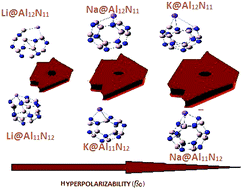Theoretical study of the non linear optical properties of alkali metal (Li, Na, K) doped aluminum nitride nanocages
Abstract
The effect of alkali metal (Li, Na, and K) doping in aluminum nitride (Al12N12) nanocages is studied through density functional theory (DFT) methods. Six new stable compounds of M@Al12N11 and M@Al11N12 are designed theoretically where alkali metal replaces an atom (Al/N) of a nanocage. The stability of the doped nano-cages is evaluated through binding energy calculations. Doping alkali atom M (M = Li, Na, K) into a nanocage significantly reduces the band gap (HOMO–LUMO gap). Polarizability and first hyperpolarizability are calculated using long range separated methods to evaluate the non-linear optical (NLO) properties of these doped systems. The hyperpolarizability of MAl12N11 nanocages is much higher than that of M@Al11N12 nanocages. The higher hyperpolarizability of M@Al12N11 nanocages is believed to arise from participation of excess diffuse electrons, revealed from PDOS.


 Please wait while we load your content...
Please wait while we load your content...